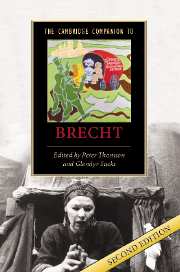Book contents
- Frontmatter
- Part I Context and Life
- Part II The Plays
- 4 Brecht’s early plays
- 5 The Threepenny Opera
- 6 Brecht’s clowns: Man is Man and after
- 7 Learning for a new society: the Lehrstück
- 8 The Good Person of Szechwan
- 9 Mother Courage and Her Children
- 10 Life of Galileo: between contemplation and the command to participate
- 11 The Caucasian Chalk Circle: the view from Europe
- Part III Theories and Practices
- Bibliography
- Index
- Series List
7 - Learning for a new society: the Lehrstück
from Part II - The Plays
Published online by Cambridge University Press: 28 March 2007
- Frontmatter
- Part I Context and Life
- Part II The Plays
- 4 Brecht’s early plays
- 5 The Threepenny Opera
- 6 Brecht’s clowns: Man is Man and after
- 7 Learning for a new society: the Lehrstück
- 8 The Good Person of Szechwan
- 9 Mother Courage and Her Children
- 10 Life of Galileo: between contemplation and the command to participate
- 11 The Caucasian Chalk Circle: the view from Europe
- Part III Theories and Practices
- Bibliography
- Index
- Series List
Summary
The centrality of the Lehrstück (learning play) to Brechtian theory was only slowly understood by a wider circle of international, critical audiences. Whether it was the lack of a comprehensive theory dealing with these works, or the Cold War hangover that rendered their texts particularly unpalatable, the result was a more-or-less total misunderstanding of this group of plays written between 1926 and 1933. A prominent and influential example of misreading was Martin Esslin's interpretation of the learning plays in his book Brecht: The Man and His Work. It is significant that Esslin translated the term Lehrstück as 'didactic plays', because in his view Brecht was writing communist thesis if not propaganda plays. Not until 1972, when Reiner Steinweg published his first volume dedicated to the construction of a coherent theory of the Lehrstück, which Brecht had provided in fragments and sketches only, was the relation of the learning plays to the rest of Brecht's work fully appreciated.
Conceived and written contemporaneously with works like Mahagonny and Radiotheorie, the learning plays belong to the nexus of Brecht's most innovative writing. In his 'Notes to Mahagonny', he drew a sharp line between renovative art, which is designed merely to stimulate audiences' appetites for cultural consumption in an effort to save the existing institutions, and genuine innovations which aim at a transformation of the entire cultural apparatus 'from places of entertainment into organs of publication'.
- Type
- Chapter
- Information
- The Cambridge Companion to Brecht , pp. 101 - 117Publisher: Cambridge University PressPrint publication year: 2006
- 5
- Cited by

